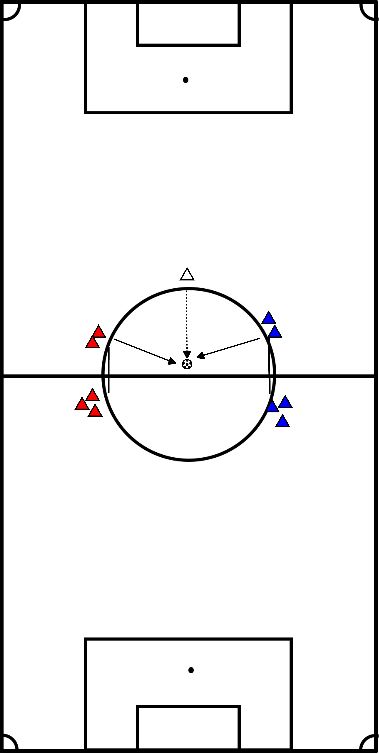Soccer drills
- Distance width the 16, other goal at 20 meters outside the 16.
- Goal: Put pressure and switch quickly.
- Execution:
- Red player works clear from 16.
- Then becomes 2:1.
- Ball outside or scored 2:3 , 4:3, 4:4.
- If you have 2 goalkeepers in your team, put them on goal.
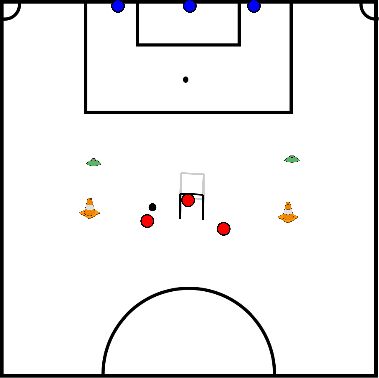
- Standing on one leg with a final goal of 10 seconds sustained with both legs.
- Attention: do not sink into the hip on the standing leg, keep knee slightly bent.
- If not successful, have knee extended or have children find light support from each other.
- Duration: +- 3 minutes.
- Distances:
- Rectangle of 15 by 5 meters.
- Pawns B and C 5 meters apart.
- Both 2.5 meters from side and 5 meters from A and D.
- Duration: 10 minutes. After 5 minutes change direction
- Explanation:
- A plays into B
- B drops ball on C
- C plays into D
- D takes the ball in the movement
- D plays it in to E
- E takes ball to start point
- Running lines: A becomes B, B becomes C etc.
- Points of attention:
- Tight balls by hitting the ball in heart body slightly over the ball
- B should drop the ball on C slightly to the outside so that there is a free pass line to D
- D's assumption in the movement and pass to E must become a fluid movement so that you can perform the action in 2 touches
- NOTE THAT THE BALL AT POINT A IS PLAYED ONLY AT THE MOMENT WHEN EVERYONE IS IN PLACE. So that point A has to wait for a while that every round is in front of them and concentration remains.
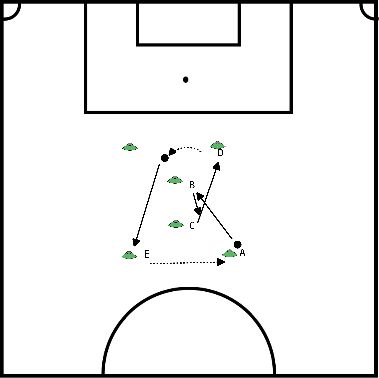
- Distances:
- Rectangle of 15 by 5 meters.
- Pawns B and C 5 meters apart.
- Both 2.5 meters from side and 5 meters from A and D.
- Duration: 10 min.
- After 5 min change direction
Explanation:
- A plays into B
- B drops the ball to C
- C passes to D
- The moment the ball reaches D, A has to be there to make the handball.
- D bounces to A and runs straight through to be played in again.
- A rebounds to D and D rebounds to E.
- E takes ball to starting point.
- Running lines: A becomes B, B becomes C etc.
Points of attention:
- Tight balls by hitting ball in heart, body slightly over ball.
- B must drop ball on C slightly to outside so there is a free pass line to D.
- A must time that he is present at the right time for the handball with D.
- If he is too early and has to wait too long it means in the match there is again opponent in his back.
- Is he too late D has to wait it means in the match that the opponent can put pressure on D.
- To maintain concentration make sure that at point A the ball is not played until everyone is in place.
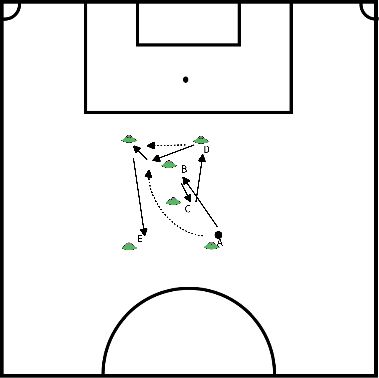
- Distances:
- Rectangle of 15 by 5 meters.
- Pawn B and C 5 meters from each other.
- Both 2.5 meters from side and 5 meters from A and D.
- Duration:
- 10 minutes. After 5 minutes change direction
Explanation:
- A plays into B.
- B drops ball on C.
- C plays D in.
- D takes the ball in the movement.
- D plays it in to E.
- Points of attention:
- Tight balls by hitting the ball in heart, body slightly over ball.
- B should drop the ball on C slightly to outside so that there is a free pass line to D.
- D's assumptions in the movement and pass to E should become a fluid movement so you can perform the action in 2 touches.
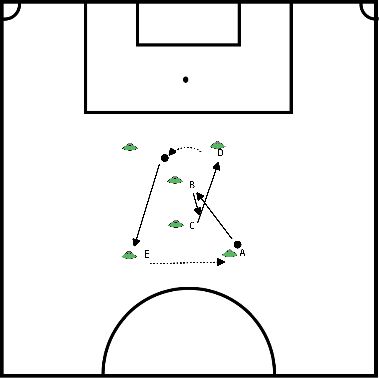
Circuit.
- Players stand left and begin to accept ball on chest thrown by trainer.
- With ball move from A to B to C to D.
- Scoring.
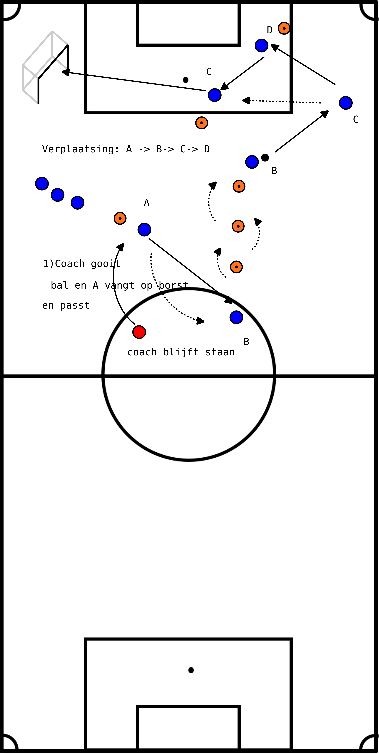
- 40% defenders and 60% attackers.
- The attackers start from the center line and should mainly focus on ball possession.
- For sloppy passes and pinging, players are punished with 5 push-ups.
- The defense starts from the 16-meter line and moves with the ball.
When 5 passes are scored, all defenders must do 5 push-ups.
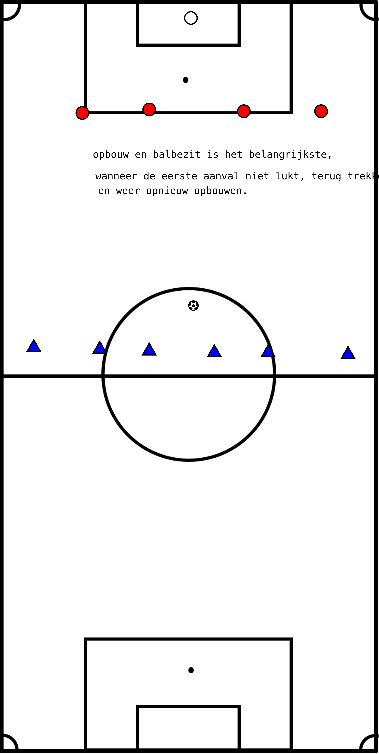
- See picture
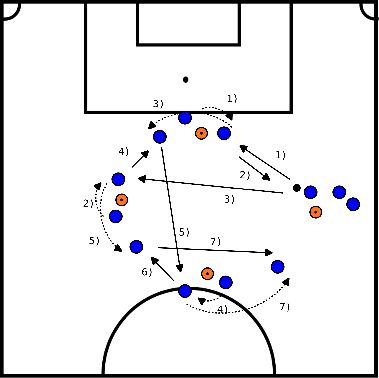
See video
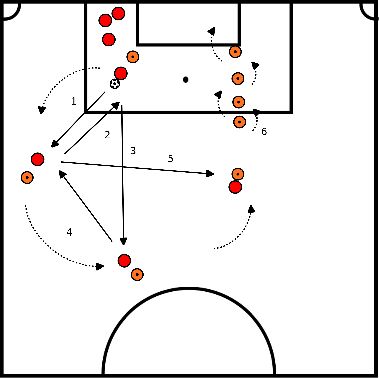
- Staircase 3 variants:
- Each step 1 step.
- Two feet in.
- Foot in foot out.
- Sprint pull up to pawn.
- Slalom around pawn with ball:
- 1x good foot.
- 1x alternate.
- 1x ball rolling under foot left and right.
- One-two with player.
- Dribble through and pass with scissors.
- Then round off.
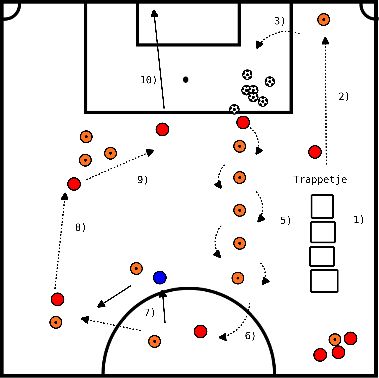
Distances: compartments 3 by 3 meters.
- Everyone stays in their box.
- Red is going to try to score by shooting the ball into one of the goals.
- The defender opposite the player with the ball steps toward him then to put pressure on the ball.
- The other defenders step in to shield the pass line.
Variants:
Harder: make boxes smaller than 3 x 3 meters.
Easier: make boxes larger than 3 x 3 meters.
Harder: make boxes smaller than 3 x 3 meters.
Easier: make boxes larger than 3 x 3 meters.
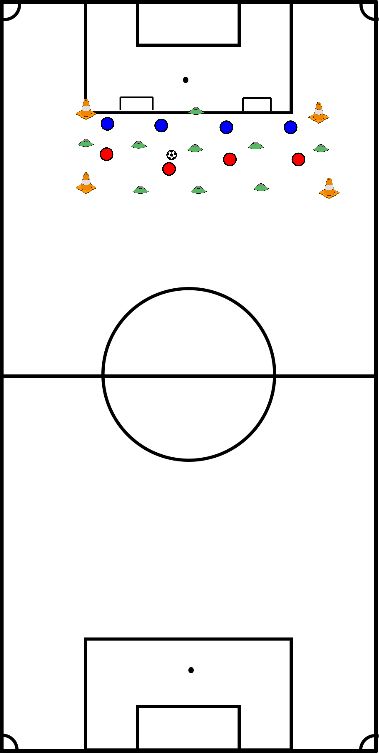
- Put two small goals on the edge of center circle facing each other.
- Make 2 teams with the same number of players.
- These line up next to the goals.
- The players choose a number from 1 to 5. With more than 10 players more numbers.
- The coach passes the ball to the center and calls out a number.
- From each team, the players with the called number play one against one on the goals.
- After a while they choose a new number.
